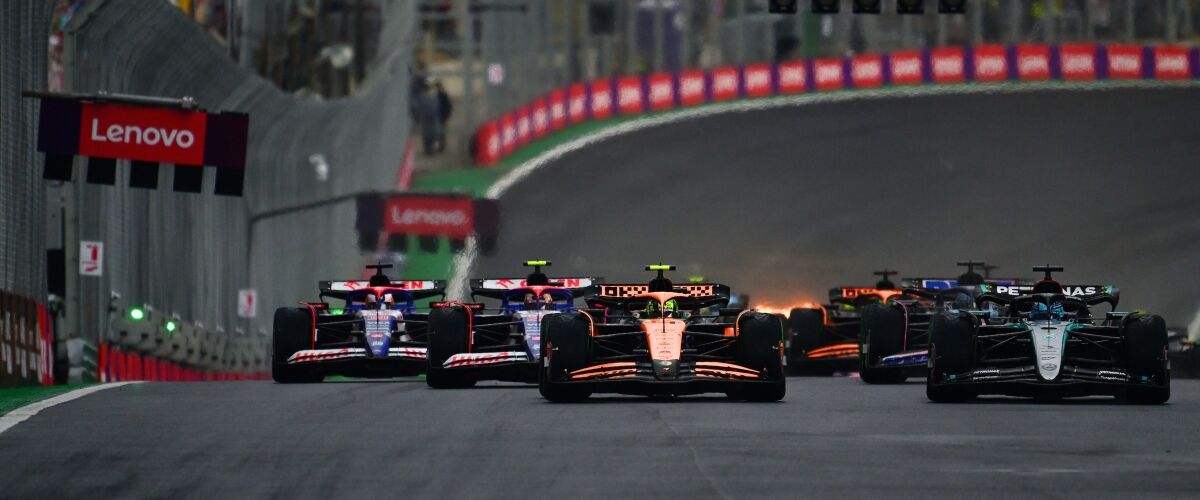Shares 0 0 0 0 0 0 No sport moves faster than Formula 1 (F1), the highest class of international racing for open-wheel single-seater formula racing cars and keeping pace with its intensity requires more than just horsepower. What happens behind the scenes for the global event, sanctioned by the Fédération Internationale de l’Automobile (FIA), from split-second camera feeds to global broadcasts and remote team collaboration, now runs on a different kind of engine: artificial intelligence (AI). At the F1 Lenovo Japanese Grand Prix 2025 that Geek Culture attended, Lenovo presented a by invitation-only front-row look into how its technology is quietly powering the experience fans see, hear, and feel.
And it’s not just about feeling the need for speed but about how technology is shaping a smarter, more sustainable future for fans and the sport alike. Over the past three years, Lenovo has become a crucial Official Technology Partner in F1’s digital transformation. Now elevated to Global Technology Partner , the company’s AI infrastructure doesn’t just support F1 operations, but also actively improves the way fans experience the race.

At the heart of the operation is Lenovo’s AI-enhanced hardware, powering real-time image correction across thousands of hours of video content. Its systems automatically detect and fix low-quality frames, ensuring each shot, whether it’s from a roll-hoop camera, a helmet cam during a critical overtake, a 360-degree view from a rear impact camera, or a drone flying over the Suzuka Circuit, is ready for broadcast without delay. “When [Lenovo] got in contact for the first time three years ago, F1 was looking for a tech partner that was able and in the position of keeping the pace of this fast environment and for getting together into the digital transformation,” Lara Rodini, Lenovo’s Global Sponsorships And Activation Director, shared in a roundtable session that Geek Culture attended in Nagoya, Japan.
“And this is the reason why [Lenovo and F1] decided to start working together.” This AI-driven infrastructure enables F1 to scale up its livestreaming capabilities without sacrificing quality. With more cameras, more content angles, and more data being captured than ever before, Lenovo’s hybrid AI approach ensures broadcast quality keeps up with fan expectations.
Whether watching from home or on a mobile screen, viewers get sharp visuals and seamless coverage thanks to Lenovo’s edge servers at the track and high-powered systems back in the UK. These systems work together to handle the enormous volume of live footage (more than 500 hours per race weekend) with minimal latency. Lenovo’s hybrid AI plays a critical role in how this data is managed and processed.
By combining public AI models with secure, private AI running on-premises, Lenovo gives F1 the flexibility to work with sensitive video and telemetry data securely while still harnessing the benefits of scalable automation. A proof of concept developed in just 90 days thanks to Lenovo’s Fast Start service, designed to help organisations prototype and deploy functional AI models, helped F1 meet growing demands for broadcast content – a real-world application that proves how hybrid AI can elevate the fan experience without compromising on speed or security. Event Technical Centre (ETC) The scale of the operation becomes clear when I step inside the Event Technical Centre (ETC), F1’s mobile broadcast nerve centre located in the Suzuka Circuit.
It takes three days to assemble, spans 25 metres x 15 metres, and houses 750 pieces of equipment running over 40 custom-built software systems. During a typical race weekend, the ETC processes up to 400GB of data and generates hundreds of official documents. Lenovo’s virtualisation platform underpins all of this with 512 CPU cores, 8.
2TB of RAM and 100TB of flash storage, all built to travel the world and perform in the toughest environments after going through extreme stress testing. Once footage is captured on-site, it’s transmitted via fibre optics to F1’s Media and Technology Centre (M&TC) in Biggin Hill, UK. That’s where colour-grading and exposure are adjusted, often in real time, before the footage is sent to broadcasters across more than 180 territories.
The M&TC hosts 270 virtual machines running on Lenovo systems with 640 CPU cores and over 100TB of flash storage; and over 400 Lenovo monitors keep operators across both locations in sync. The entire operation runs with bandwidth peaking at 8.5 Gbps, ensuring what fans see is both live globally in a split second, and polished.
F1’s Media and Technology Centre (M&TC) Cameras alone tell part of the story. A typical Grand Prix weekend involves deploying over 93 onboard car cameras with up to 9 cameras per car, including forwards and rear from the roll hoop, a face view camera, helmet camera, pedal camera, and an additional camera either on the side or nose of the chassis. Additionally, they have a 360-degree camera that records at least 72GB of film during qualifying and 480GB of footage from the race.
Lastly, there are the cable camera, five RF cameras in the pitlane, three pit wall cameras, two wander cameras, two podium cameras, and the Giro Stabilised Heli-cam. More than 150 microphones also capture stereo audio from F1, F2, F3, F1 Academy, Porsche Supercup and FIA vehicles. The result? Over 500 hours of live broadcast content for all 24 races across five continents, and more than 8,000 videos created annually for social platforms with over 750 million fans which racked up 12 billion views in 2024 alone.
Fans tuning in may not think twice about how seamless the action looks on screen. But behind every high-speed replay and real-time graphic sits a network of smart devices working quietly in the background, many of them powered by Lenovo’s AI-optimised PCs and workstations. These machines such as Lenovo’s laptops (ThinkPad and IdeaPad), desktops (ThinkStation & ThinkCentre), and monitors (ThinkVision) support the broadcast team with faster graphics rendering, smoother production workflows, and more efficient livestream delivery.
During the Chinese Grand Prix held on 23 March 2025 at the Shanghai International Circuit, F1 piloted Lenovo’s AI PC X1 Carbon Aura Edition to test its role in live operations with immediate feedback. Trackside teams reported improvements in battery life and system responsiveness, while the AI integration made everyday tasks, like content creation and real-time collaboration, quicker and more intuitive. Built-in features like Smart Care offered system insights, while compatibility with Copilot and Copilot+ helped support AI-assisted decision-making on the go.
For remote and mobile teams, it’s a workhorse that keeps up no matter where they’re based. Smart Share, one of the standout features of Lenovo’s Aura Edition, also made an appearance during the testing. Designed to streamline file transfers between phone and PC, Smart Share uses AI-powered tap detection to move content, like race-day photos, video clips, or broadcast files, instantly with a single tap, simplifying workflows between mobile devices and Lenovo PCs in the media team.
While the focus on speed and efficiency is paramount, Lenovo and F1 are also committed to a sustainable future, minimising the sport’s environmental footprint. As F1 continues pushing toward a net-zero carbon goal by the end of the decade, Lenovo plays a central role in helping the sport reduce its environmental footprint, without compromising on speed or spectacle. A key enabler of this shift is Lenovo’s Asset Recovery Services (ARS), which allows F1 to securely dispose of retired tech, recycle materials, and repurpose hardware wherever possible.
Doing so not only supports a more environmentally responsible workflow, but also offsets the cost of hardware refresh cycles. For fans, this means fewer e-waste concerns and more confidence that the tech supporting the show is part of a longer, greener plan. Speaking on the partnership’s sustainable direction, Rodini shared, “One of the other important pillars of this collaboration is sustainability, which is a must as well.
Since the beginning, F1 is, for example, using our asset recovery service. And with this in mind, we have been developing and taking together a unique technology centre, which is based back in the UK, where we reduced the number of the hardware that was in use, and we specifically disposed of the majority. So it’s something that we keep carrying on together.
Really important goals are set up as well for redemption.” Hardware downsizing has also helped reduce the physical and environmental load of the sport. Compact devices like the Lenovo P3 Tiny workstations have replaced bulkier, high-power renderers, shrinking freight requirements and helping to cut transport emissions.
It’s a small shift in hardware, but a substantial gain in sustainability, especially when multiplied across 24 races and five continents. At the data centre level, Lenovo’s Neptune warm-water cooling system supports high-performance computing while saving in energy usage. “When you actually cool the infrastructure using warm water, you can save up to 40% in a data centre power.
It can bring up 200% efficiency in your data center cooling. So these are aspects which are very, very important,” says Sumir Bhatia, Lenovo’s President of the Asia Pacific Infrastructure Solutions Group. It’s a practical solution to the growing demand for AI computers, offering efficiency without increasing the sport’s carbon footprint.
As more of these systems are deployed, fans benefit from richer, faster content delivery powered by quieter, cooler, and more energy-efficient technology. But the experience doesn’t stop at broadcast. With Motorola’s appointment as Global Smartphone Partner of F1, mobile fans are starting to see how handheld devices can become second screens, or even primary ones.
Models like the Motorola Edge 20 Pro, Motorola Edge 30 Ultra, ThinkPhone, and the Motorola RAZR 40 Ultra sync effortlessly with Lenovo PCs, enabling faster content sharing, and personalising race content depending on where and how fans choose to watch. “The Global Partnership position brought the upgrade of Motorola to Global Smartphone Partner,” said Rodini. “And so we give the possibility to Motorola, which is a Lenovo company, of building and increasing, not only the brand awareness, also in this case, but even more working on the tech side, providing an experience and even more focused experience for the F1 organisation.
” With over 600 F1 employees already using Lenovo and Motorola devices, from executives to on-ground engineers, the foundation is in place for a new kind of race weekend. One where fans don’t just watch the race, but live it through smarter interfaces, personalised content, and frictionless tech that keeps up with the pace of the world’s fastest sport. Lenovo’s full-stack approach, from hardware to cloud, provides a runway for innovation without sacrificing sustainability or stability.
For fans, that means a viewing experience that gets better with each season. Smarter graphics. Customised feeds.
Mobile-first interaction. The tech may be invisible, but its impact is not. And if the goal is to make the world’s most advanced motorsport even more human, more personal, and more connected, Lenovo is proving that the best seat at the race might be in your hand, on your screen, or just one AI-powered update away.
Natalie Natalie is a big fan of anything related to movies, TV shows, and anime — you name it. When she’s not reading or being a dedicated cinephile, she’s probably playing gacha and tabletop games, or daydreaming of Caleb from Love and Deepspace . F1 Formula 1 Formula One Japan Lenovo motorola Lifting the curtain on the ThinkPad legacy.
Chair-llenging the pole position for comfort. More ways to play outside of the Steam Deck..
Entertainment

Driving The Future: Lenovo’s AI Powers A More Immersive & Sustainable Formula 1 2025 Race

The checkered flag is nowhere in sight as F1 and Lenovo accelerate into the future together.The post Driving The Future: Lenovo’s AI Powers A More Immersive & Sustainable Formula 1 2025 Race appeared first on Geek Culture.















